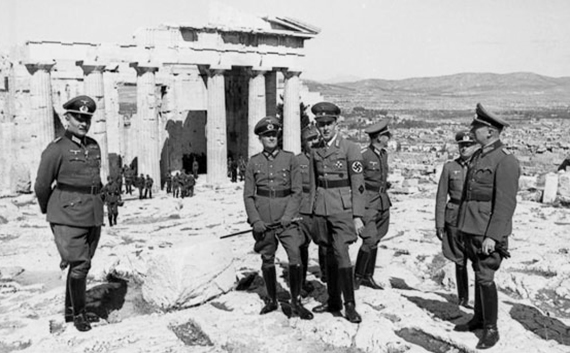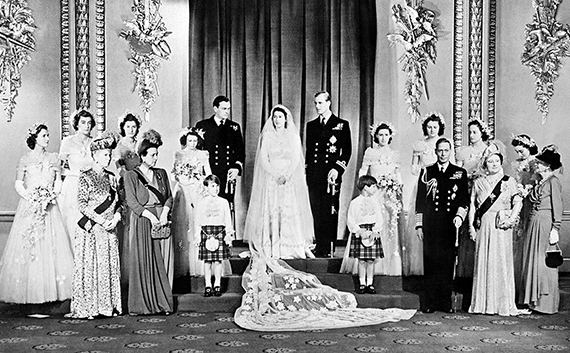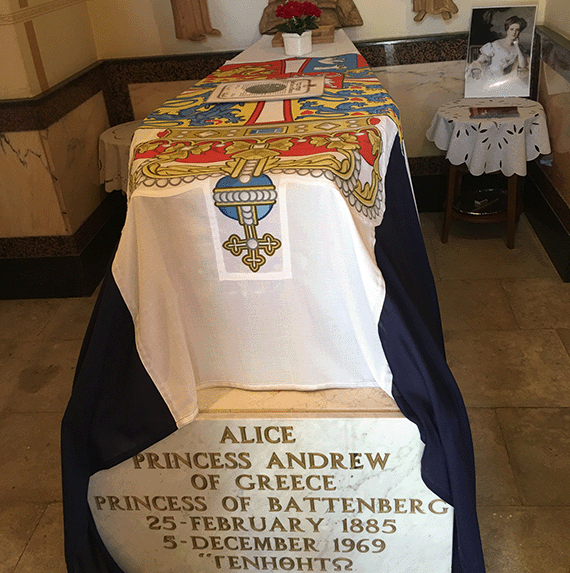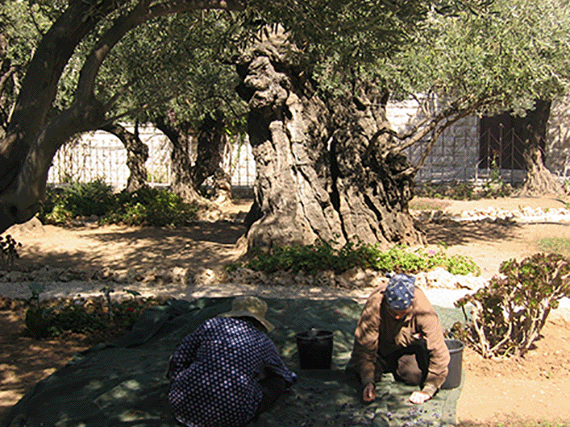|
 |
|
 |
|
 |
|
|
|
Princess Alice, mother of Prince Philip
(Duke of Edinburgh) and mother-in-law of
Queen Elizabeth, was born in Windsor Castle
in 1885. Her great-grandmother was Queen
Victoria who was still alive when she was
born. Alice was related to most of the
European pre-World War royalty, yet her
exemplary life with its unexpected twists
and turns may have been the most turbulent
among all her cousins. |
|
|
|
When she died in 1969, she was buried at
Windsor Castle (just as her son Philip was
in April 2021). But 19 years later,
according to a request before her death, her
bones were transferred to the Church of Mary
Magdalena, on the slopes of the Mount of
Olives above Gethsemane in Jerusalem. |
|
|
|
 |
|
Engraving
of Windsor Castle in Wikipedia Commons |
|
Princess Alice,
great-granddaughter of Queen Victoria was
born in Windsor Castle
|
|
|
|
 |
|
Photo:
Gila Yudkin |
|
Princess Alice's final
resting place in the Church of Mary
Magdalena in Jerusalem |
|
| Therefore, on the Day of the Great
Reckoning, according to Jewish, Christian
and Muslim tradition, she will be among the
first to rise up. Then she can share the
full details of her unconventional and
tumultuous life. In the meantime, this is
what we know…. |
|
|
Princess Alice was born deaf. By the age of
eight, with the prodding of her mother who
believed in “tough love”, she was a fluent
lip reader. By age eighteen, she could not
only speak clearly, but she could lip read
in three languages.
|
|
|
|
Alice was raised in the privileged style of
“English princess”. Like a fairy tale, she
met the dashing Prince Andreas of Greece and
Denmark at the coronation of her great
uncle, King Edward VII of England. They fell
in love and were married in October 1903. Their wedding was one of the last large
gatherings of European royals before the
First World War.
|
|
|
 |
|
Photo in
the public domain |
|
In the beginning, the life
of Princess Alice was like a fairy tale |
|
|
The couple settled into a wing of the Royal
Palace in Athens and went on to have five
children, four daughters and a son. During
the 1912 Balkan Wars between the Greeks and
the Turks, Alice left her children and went
to work as a nurse on the frontlines. |
|
|
|
While Andres pursued his military career
(and other women),
Alice raised her family and became very
involved in charity work. However, the
political situation in Greece was touch and
go, extremely unstable, and the family was
forced into exile several times.
|
|
| In 1922, one year after Prince Philip was
delivered on a kitchen table in Alice’s
country home, the King (Alice’s
father-in-law) was forced to abdicate and
Prince Andreas was arrested and charged with
treason. He was court-martialed and
convicted and would have probably been
executed had it not been for the
intervention of Alice’s cousin, King George
V of England. |
|
| When Prince Andrew was given a stay of
execution, the family seized the opportunity
to flee. With Prince Philip stored in an
orange crate under a make-shift cot, Alice
and her family boarded a British warship and
sailed into a humiliating exile. Her
conventional life as a princess was over. |
|
|
The family ended up as refugees outside
Paris. They had lost their fortune and had
to live off their rich relatives. Alice
worked with Greek refugees and steadily
became more and more devout. In 1928 she
quietly converted to the Greek Orthodox
Church. Soon Alice began to show signs of
mental illness.
|
|
|
|
In desperation, the family turned to the new
science of psychiatry. In 1930 she
checked herself into a psychiatric hospital
outside of Berlin. She then found
herself in the company of Europe's most
(loony) disturbed psychiatric patients –
those with obsessive disorders and those
with addictions. She was diagnosed
with paranoid schizophrenia and believed
herself to be in an intimate relationship
not only with Jesus, but also with Buddha.
|
|
|
|
The head of the psychiatric hospital
appealed to Sigmund Freud for help when he
visited the premises. Freud recommended that
Princess Alice be given x-rays to her
ovaries to cool down her libido, her sexual
excitement. Later, Princess Alice wrote that
the renowned psychiatrist “was not a kind
man.”
|
|
|
|
Then she was sent by her family to a
sanitarium in Switzerland. She was basically
a prisoner for two and a half years while
her husband carried on an independent life
in Southern France. All four of her
daughters married German princes who became
officers in Hitler’s army. She did not
attend their weddings. Her son Philip, from
age 10, was sent off to boarding schools and
was shuffled off to various branches of the
family for school holidays. |
|
|
|
In 1938 when the Greek monarchy was
restored, Alice returned to Athens. Along
with her sister-in-law, Alice worked with
the Red Cross during WW II to organize food
and shelter for orphaned children in the
poorer neighborhoods of Athens. She wanted
Philip to come live with her in Athens. But
he seemed to have a promising future in the
British Royal Navy with his uncle Lord
Mountbatten. |
|
|
|
In 1940 Hitler's armies conquered Greece and
in 1941 the swastika was raised over the
Acropolis. Alice found herself alone in Nazi
occupied Greece with her son fighting in
Britain's royal navy. She worked in a soup
kitchen in Athens. Then they ran out of
food. |
|
|
|
 |
|
Archive
photo of Segula |
|
Greece Surrenders to Nazi
Germany in April 1941 (with Princess Alice
in Athens) |
|
|
|
In 1943, after the German Army had occupied
Athens, and while most Jews (90%) were being
deported to concentration camps, Alice hid a
Jewish widow, Rachel Cohen and two of her
children on the top floor of her residence
in central Athens. Thirty years earlier,
Mrs. Cohen’s husband had come to the aid of
King George I of Greece. The monarch had
offered to someday repay him if there was
ever anything he could do for him. Mrs.
Cohen remembered this promise and reached
out to Princess Alice who took the family
in, risking her own life in doing so. |
|
|
|
The Gestapo was suspicious of Alice, even
questioning her, but the princess turned her
disability into a weapon. She
pretended not to understand their questions.
For thirteen months until liberation, she
hid the Cohen family members from the Nazis
(and from her daughters married to German
officers). For this act of courage,
she was posthumously recognized as a member
of the “righteous among the nations” at
Israel’s Holocaust Memorial, Yad Vashem.
(And by the way, she never told either her
son Philip or her daughters that she had
hidden a Jewish family in her Athenian
palace during the Nazi occupation.
Philip only found out when contacted by Yad
Vashem in 1993.) |
|
|
|
In November 1947, Alice returned to the UK
for her son Philip’s wedding to the Princess
Elizabeth. Some of her jewels were used to
create Elizabeth’s engagement ring, as well
as a bracelet that Philip designed for her
as a wedding gift. None of Alice’s daughters
had been invited to the royal wedding due to
their marriage to German princes. |
|
|
|
 |
|
Photo in the public domain |
|
Alice is at the extreme
right in this official photo of Elizabeth
and Philip's wedding |
|
| After the wedding, Alice disappeared. Until
the coronation of Elizabeth in June 1953
when Alice was spotted in the royal
procession. Wearing a gown designed to look
like a nun’s habit, she led the formal
procession of Philip’s family, including his
three surviving sisters and his uncle. |
|
| After the
coronation, Alice returned to Greece,
working to help the poor and those in need.
She had founded a Greek Orthodox religious
order of nurses called the Sisterhood of
Martha and Mary. |
|
| With the military coup in 1967 and her
children’s growing concern for her safety,
it became obvious that she would need to
leave the country that she’d grown to love
so much since first arriving in 1903. Even
so, Alice refused to bulge until Philip sent
a plane to bring her home. She moved into a
small apartment in Buckingham Palace. |
|
|
 |
|
Photo in the public domain |
|
Duke of Edinburgh
escorting his mother into Westminster Abbey
on July 3, 1960 |
|
| Family and staff joked about a particular
corridor in Buckingham Palace smelling of
Woodbine -- a brand of tobacco associated
with working-class men. It turned out that
Alice had picked up the habit from all the British
servicemen that she had nursed as a nun
during the war.
She was considered quite a character.
About her unconventionality, her own mother
is reported to have said, “What can you say
of a nun who smokes and plays canasta?" |
|
| At the age of 84, Princess Alice died at
Buckingham Palace in December 1969.
Following her funeral, her remains were
placed in the royal Crypt at St George’s
Chapel, Windsor Castle. Alas, there was one
more surprise for her family. |
Her final wish was to be buried on the Mount
of Olives near her aunt Ella, Grand Duchess
Elizabeth Feodorovna of Russia at the
Convent of Saint Mary Magdalena on the Mount
of Olives in Jerusalem. On August 3, 1988,
nearly 19 years after her death, her remains
were moved to Jerusalem and placed in a
crypt below the church. |
|
|
|
 |
|
Photo:
Gila Yudkin |
|
Tombstone of Princess
Alice at the Church of Mary Magdalena in
Jerusalem |
|
Visited by her grandson
Prince Charles (2020) and great-grandson
William (2018) |
|
|
|
Copyright 2021 Gila Yudkin. Permission
needed for any reuse. |
|
|
|
 |
|
Photo:
Gila Yudkin |
|
Onion domes atop the
Church of Mary Magdalena final resting place
of Princess Alice |
|
|
|
March
2023 UPDATE |
|
|
Olive oil from the Mount of Olives has been
consecrated at the
Church of the Holy Sepulcher
to be used in the coronation of
Charles III on May 6 at London’s Westminster
Abbey. The oil, pressed from olives
grown on the Mount of Olives near the final
resting place of Princess Alice, Charles’
grandmother, will be perfumed with essential
oils --
rose, jasmine, cinnamon, and amber -- as
well as orange blossom for the ceremony,
based on the same formula as the oil used in
the coronation of Queen Elizabeth in 1953.
Starting with the kings of Israel and Judah
to the present day, monarchs have been
anointed with sacred oil. See First
Samuel chapter 10 for the anointing of Saul,
first king of Israel, and chapter 16 for the
anointing of David. |
|
|
|
 |
|
Photo:
Gila Yudkin |
|
Harvesting
olives at the Garden of Gethsemane, just a
few meters below the final resting place of
Princess Alice in the Church of Mary
Magdalena |
|
|

